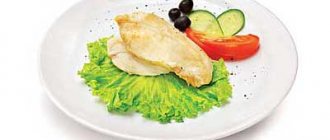Omelette is a classic breakfast option. There are always eggs in the house, as well as a drop of milk and a couple of pinches of spices to vary the taste. And if there are other hearty ingredients in the refrigerator, then the omelette can turn into a truly royal dish. In our country, it is traditionally prepared by adding milk, often baked in the oven or cooked in a frying pan with the lid closed and on the lowest heat, which allows you to achieve a juicy and tender texture, more like a soufflé in the classic interpretation.
Ingredients Omelette with cheese
| Natural omelette | 165.0 (gram) |
| hard cheese | 20.0 (gram) |
| margarine | 10.0 (gram) |
| butter | 5.0 (gram) |
The omelette mixture is mixed with grated cheese, fried or baked like a natural omelette (recipe No. 284). When leaving, pour melted fat over it.
Nutritional value and chemical composition of “Omelette with cheese”.
| Nutrient | Quantity | Norm** | % of the norm in 100 g | % of the norm in 100 kcal | 100% normal |
| Calorie content | 342 kcal | 1684 kcal | 20.3% | 5.9% | 492 g |
| Squirrels | 16.3 g | 76 g | 21.4% | 6.3% | 466 g |
| Fats | 29.7 g | 56 g | 53% | 15.5% | 189 g |
| Carbohydrates | 2.6 g | 219 g | 1.2% | 0.4% | 8423 g |
| Organic acids | 0.03 g | ||||
| Vitamin B1, thiamine | 0.08 mg | 1.5 mg | 5.3% | 1.5% | 1875 |
| Vitamin B2, riboflavin | 0.5 mg | 1.8 mg | 27.8% | 8.1% | 360 g |
| Vitamin B4, choline | 258.7 mg | 500 mg | 51.7% | 15.1% | 193 g |
| Vitamin B5, pantothenic | 1.4 mg | 5 mg | 28% | 8.2% | 357 g |
| Vitamin B6, pyridoxine | 0.2 mg | 2 mg | 10% | 2.9% | 1000 g |
| Vitamin B9, folates | 10.1 mcg | 400 mcg | 2.5% | 0.7% | 3960 g |
| Vitamin B12, cobalamin | 0.8 mcg | 3 mcg | 26.7% | 7.8% | 375 g |
| Vitamin C, ascorbic acid | 0.4 mg | 90 mg | 0.4% | 0.1% | 22500 g |
| Vitamin D, calciferol | 2.2 mcg | 10 mcg | 22% | 6.4% | 455 g |
| Vitamin E, alpha tocopherol, TE | 5.3 mg | 15 mg | 35.3% | 10.3% | 283 g |
| Vitamin H, biotin | 21.1 mcg | 50 mcg | 42.2% | 12.3% | 237 g |
| Vitamin RR, NE | 3.0058 mg | 20 mg | 15% | 4.4% | 665 g |
| Niacin | 0.3 mg | ||||
| Macronutrients | |||||
| Potassium, K | 194.5 mg | 2500 mg | 7.8% | 2.3% | 1285 g |
| Calcium, Ca | 190 mg | 1000 mg | 19% | 5.6% | 526 g |
| Magnesium, Mg | 21.1 mg | 400 mg | 5.3% | 1.5% | 1896 |
| Sodium, Na | 254.2 mg | 1300 mg | 19.6% | 5.7% | 511 g |
| Sera, S | 184.9 mg | 1000 mg | 18.5% | 5.4% | 541 g |
| Phosphorus, Ph | 269 mg | 800 mg | 33.6% | 9.8% | 297 g |
| Chlorine, Cl | 187.9 mg | 2300 mg | 8.2% | 2.4% | 1224 g |
| Microelements | |||||
| Aluminium, Al | 14.3 mcg | ||||
| Iron, Fe | 2.6 mg | 18 mg | 14.4% | 4.2% | 692 g |
| Yod, I | 22.6 mcg | 150 mcg | 15.1% | 4.4% | 664 g |
| Cobalt, Co | 10.3 mcg | 10 mcg | 103% | 30.1% | 97 g |
| Manganese, Mn | 0.0406 mg | 2 mg | 2% | 0.6% | 4926 g |
| Copper, Cu | 93.6 mcg | 1000 mcg | 9.4% | 2.7% | 1068 g |
| Molybdenum, Mo | 7.4 mcg | 70 mcg | 10.6% | 3.1% | 946 g |
| Tin, Sn | 3.7 mcg | ||||
| Fluorine, F | 60.9 mcg | 4000 mcg | 1.5% | 0.4% | 6568 g |
| Chromium, Cr | 4.6 mcg | 50 mcg | 9.2% | 2.7% | 1087 g |
| Zinc, Zn | 1.6205 mg | 12 mg | 13.5% | 3.9% | 741 g |
| Digestible carbohydrates | |||||
| Mono- and disaccharides (sugars) | 2.1 g | max 100 g | |||
| Sterols (sterols) | |||||
| Cholesterol | 543.5 mg | max 300 mg |
The energy value of Omelette with cheese is 342 kcal.
Main source: Internet. Read more.
** This table shows the average levels of vitamins and minerals for an adult. If you want to know the norms taking into account your gender, age and other factors, then use the “My Healthy Diet” application.
How to reduce the calorie content of an omelet?
A low-calorie omelette can be obtained by eliminating oil from its composition. But you need to understand that in this case it should be cooked in one of the following ways:
- in the oven;
- in a slow cooker;
- in a steamer;
- in the microwave.
Or you can use a regular package. To do this, pour a beaten mass of 3 eggs and 150 ml of milk into a bag and tie it tightly. For reliability, the resulting bag is placed in another one, also tied well. Pour 1 liter of water into a saucepan and place on fire. Gradually lower the bag into boiling water. Cook the mixture over low heat for 25 minutes. The calorie content of the dish will be 85 kcal.
Another way to reduce the fat content of an omelet is to make it with only whites and replace the milk with water. If you can’t give up yolks, then reduce the number of eggs altogether. For example, instead of 2 eggs, take one and replace the second with vegetables and herbs. Use dill, basil, parsley. For true gourmets, oregano, cilantro, rosemary or celery are suitable.
What are the benefits of Omelette with cheese?
- Vitamin A
is responsible for normal development, reproductive function, skin and eye health, and maintaining immunity. - Vitamin B2
is involved in redox reactions, helps to increase the color sensitivity of the visual analyzer and dark adaptation. Insufficient intake of vitamin B2 is accompanied by impaired condition of the skin, mucous membranes, and impaired light and twilight vision. - Choline
is part of lecithin, plays a role in the synthesis and metabolism of phospholipids in the liver, is a source of free methyl groups, and acts as a lipotropic factor. - Vitamin B5
is involved in protein, fat, carbohydrate metabolism, cholesterol metabolism, the synthesis of a number of hormones, hemoglobin, promotes the absorption of amino acids and sugars in the intestines, and supports the function of the adrenal cortex. A lack of pantothenic acid can lead to damage to the skin and mucous membranes. - Vitamin B12
plays an important role in the metabolism and transformation of amino acids. Folate and vitamin B12 are interconnected vitamins that are involved in hematopoiesis. A lack of vitamin B12 leads to the development of partial or secondary folate deficiency, as well as anemia, leukopenia, and thrombocytopenia. - Vitamin D
maintains calcium and phosphorus homeostasis and carries out the processes of bone tissue mineralization. A lack of vitamin D leads to impaired metabolism of calcium and phosphorus in the bones, increased demineralization of bone tissue, which leads to an increased risk of developing osteoporosis. - Vitamin E
has antioxidant properties, is necessary for the functioning of the gonads and heart muscle, and is a universal stabilizer of cell membranes. With vitamin E deficiency, hemolysis of erythrocytes and neurological disorders are observed. - Vitamin H
is involved in the synthesis of fats, glycogen, and amino acid metabolism. Insufficient consumption of this vitamin can lead to disruption of the normal condition of the skin. - Vitamin PP
is involved in redox reactions of energy metabolism. Insufficient vitamin intake is accompanied by disruption of the normal condition of the skin, gastrointestinal tract and nervous system. - Calcium
is the main component of our bones, acts as a regulator of the nervous system, and is involved in muscle contraction. Calcium deficiency leads to demineralization of the spine, pelvic bones and lower extremities, increasing the risk of developing osteoporosis. - Phosphorus
takes part in many physiological processes, including energy metabolism, regulates acid-base balance, is part of phospholipids, nucleotides and nucleic acids, and is necessary for the mineralization of bones and teeth. Deficiency leads to anorexia, anemia, and rickets. - Iron
is part of proteins with various functions, including enzymes. Participates in the transport of electrons and oxygen, ensures the occurrence of redox reactions and activation of peroxidation. Insufficient consumption leads to hypochromic anemia, myoglobin deficiency atony of skeletal muscles, increased fatigue, myocardiopathy, and atrophic gastritis. - Iodine
is involved in the functioning of the thyroid gland, ensuring the formation of hormones (thyroxine and triiodothyronine). Necessary for the growth and differentiation of cells of all tissues of the human body, mitochondrial respiration, regulation of transmembrane transport of sodium and hormones. Insufficient intake leads to endemic goiter with hypothyroidism and slowing of metabolism, arterial hypotension, stunted growth and mental development in children. - Cobalt
is part of vitamin B12. Activates enzymes of fatty acid metabolism and folic acid metabolism. - Zinc
is part of more than 300 enzymes and is involved in the processes of synthesis and breakdown of carbohydrates, proteins, fats, nucleic acids and in the regulation of the expression of a number of genes. Insufficient consumption leads to anemia, secondary immunodeficiency, liver cirrhosis, sexual dysfunction, and the presence of fetal malformations. Research in recent years has revealed the ability of high doses of zinc to disrupt the absorption of copper and thereby contribute to the development of anemia.
still hide
You can see a complete guide to the healthiest foods in the “My Healthy Diet” app.
source
Ingredients for omelette with cheese (oven)
| Chicken egg (Baked) | 168 g |
| Pasteurized milk 3.2% fat (Baking) | 111 g |
| Oltermani cheese 9% | 135 g |
| Table salt | 2 g |
Nutritional value and chemical composition of “omelet with cheese (oven)”.
| Nutrient | Quantity | Norm** | % of the norm in 100 g | % of the norm in 100 kcal | 100% normal |
| Calorie content | 153.8 kcal | 1684 kcal | 9.1% | 5.9% | 1095 g |
| Squirrels | 17 g | 76 g | 22.4% | 14.6% | 447 g |
| Fats | 8.6 g | 56 g | 15.4% | 10% | 651 g |
| Carbohydrates | 2 g | 219 g | 0.9% | 0.6% | 10950 g |
| Water | 49 g | 2273 g | 2.2% | 1.4% | 4639 g |
| Vitamins | |||||
| Vitamin A, RE | 119.5 mcg | 900 mcg | 13.3% | 8.6% | 753 g |
| beta carotene | 0.026 mg | 5 mg | 0.5% | 0.3% | 19231 g |
| Vitamin B1, thiamine | 0.037 mg | 1.5 mg | 2.5% | 1.6% | 4054 g |
| Vitamin B2, riboflavin | 0.229 mg | 1.8 mg | 12.7% | 8.3% | 786 g |
| Vitamin B4, choline | 116.33 mg | 500 mg | 23.3% | 15.1% | 430 g |
| Vitamin B5, pantothenic | 0.683 mg | 5 mg | 13.7% | 8.9% | 732 g |
| Vitamin B6, pyridoxine | 0.076 mg | 2 mg | 3.8% | 2.5% | 2632 g |
| Vitamin B9, folates | 4.496 mcg | 400 mcg | 1.1% | 0.7% | 8897 g |
| Vitamin B12, cobalamin | 0.693 mcg | 3 mcg | 23.1% | 15% | 433 g |
| Vitamin C, ascorbic acid | 0.19 mg | 90 mg | 0.2% | 0.1% | 47368 g |
| Vitamin D, calciferol | 0.974 mcg | 10 mcg | 9.7% | 6.3% | 1027 g |
| Vitamin E, alpha tocopherol, TE | 0.262 mg | 15 mg | 1.7% | 1.1% | 5725 g |
| Vitamin H, biotin | 9.737 mcg | 50 mcg | 19.5% | 12.7% | 514 g |
| Vitamin K, phylloquinone | 0.1 mcg | 120 mcg | 0.1% | 0.1% | 120000 g |
| Vitamin RR, NE | 1.8016 mg | 20 mg | 9% | 5.9% | 1110 g |
| Macronutrients | |||||
| Potassium, K | 99.02 mg | 2500 mg | 4% | 2.6% | 2525 g |
| Calcium, Ca | 372.63 mg | 1000 mg | 37.3% | 24.3% | 268 g |
| Magnesium, Mg | 8.98 mg | 400 mg | 2.2% | 1.4% | 4454 g |
| Sodium, Na | 272.54 mg | 1300 mg | 21% | 13.7% | 477 g |
| Sera, S | 86.1 mg | 1000 mg | 8.6% | 5.6% | 1161 g |
| Phosphorus, Ph | 107.5 mg | 800 mg | 13.4% | 8.7% | 744 g |
| Chlorine, Cl | 409.86 mg | 2300 mg | 17.8% | 11.6% | 561 g |
| Microelements | |||||
| Iron, Fe | 1.132 mg | 18 mg | 6.3% | 4.1% | 1590 g |
| Yod, I | 11.32 mcg | 150 mcg | 7.5% | 4.9% | 1325 g |
| Cobalt, Co | 4.672 mcg | 10 mcg | 46.7% | 30.4% | 214 g |
| Manganese, Mn | 0.0157 mg | 2 mg | 0.8% | 0.5% | 12739 g |
| Copper, Cu | 41.09 mcg | 1000 mcg | 4.1% | 2.7% | 2434 g |
| Molybdenum, Mo | 4.631 mcg | 70 mcg | 6.6% | 4.3% | 1512 g |
| Selenium, Se | 14.409 mcg | 55 mcg | 26.2% | 17% | 382 g |
| Fluorine, F | 29.77 mcg | 4000 mcg | 0.7% | 0.5% | 13436 g |
| Chromium, Cr | 2.32 mcg | 50 mcg | 4.6% | 3% | 2155 g |
| Zinc, Zn | 0.6028 mg | 12 mg | 5% | 3.3% | 1991 |
| Sterols (sterols) | |||||
| Cholesterol | 251.3 mg | max 300 mg |
The energy value of an omelet with cheese (oven) is 153.8 kcal.
Primary Source: Created in the application by the user. Read more.
** This table shows the average levels of vitamins and minerals for an adult. If you want to know the norms taking into account your gender, age and other factors, then use the “My Healthy Diet” application.
source
Ingredients Omelette with cheese and garlic
| Poshekhonsky cheese | 250 g |
| Parsley | 5 g |
| Dill | 5 g |
| Garlic bulb | 5 g |
| Mayonnaise "Provencal" | 50 g |
| omelet for 4 eggs | 300 g |
Nutritional value and chemical composition of “Omelette with cheese and garlic.”
The energy value of Omelette with cheese and garlic is 267.5 kcal.
Primary Source: Created in the application by the user. Read more.
** This table shows the average levels of vitamins and minerals for an adult. If you want to know the norms taking into account your gender, age and other factors, then use the “My Healthy Diet” application.
What kind of omelet is possible on a diet?

Having figured out how many calories are in an omelet made from 2 eggs and milk, it’s time to think about how much of a dietary dish this really is. Many are accustomed to perceive it as breakfast and 240 kcal is not quite what seems acceptable. Especially if you also add vegetables, a couple of breads, and beans. The classic omelette made from large eggs is indeed not the easiest, but it will be more than dietary if you follow only 2 rules:
- Do not fry in oil - it is better to buy a good frying pan with a non-stick coating. The omelette will still have a crust, but you won’t have to use any fat.
- Take only egg whites: the main weight of the egg is the yolk. If you use only the protein from 2 eggs, it will be only 40-70 g. At the same time, the calorie content of 100 g of protein is only 44 kcal. Such an omelet, and even with lactose-free milk, will have only 45 kcal. And this includes large eggs.
Also, do not forget that in an omelet with a full egg (with yolk) there is enough fat, so you should not serve the dish with cheese. Just as it is undesirable to combine it with sausage, frankfurters, meat - the result will be a difficult tandem to digest, and even with a high calorie content. Dilute the composition with herbs, cucumbers, and peppers. And if the milk in the refrigerator is only full-fat, dilute it half and half with water.










